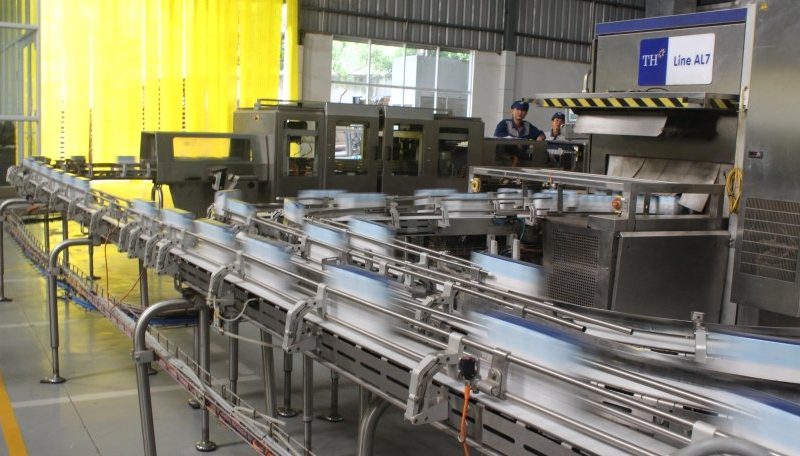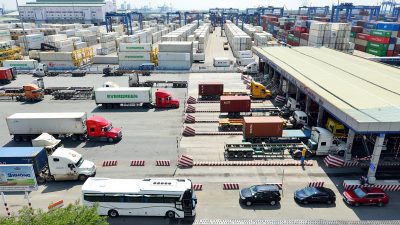
|
Despite massive woes caused by the COVID-19 pandemic affecting the economy’s performance, the quality of the country’s economic growth has enjoyed step-by-step amelioration, with growing interest from investors and a national dream of becoming a digitalised economy in favour of people and businesses. |
|
On the afternoon of March 1, 2022, Prime Minister Pham Minh Chinh talked over the phone with CEO of Adidas Kasper Rorsted in order to discuss solutions for promoting the German sportwear firm’s operations in Vietnam. PM Chinh described Adidas’ sustainable operations in Vietnam as a demonstration of the resolve, efforts, and effectiveness of the close and fruitful cooperation between Vietnamese government agencies and localities and foreign enterprises and investors in the spirit of “harmonising interests and sharing risks”. Underlining the Vietnamese government’s big priority on green growth and greenhouse gas (GHG) emission reduction, PM Chinh spoke highly of Adidas’s commitment to sustainable business, environmental protection, and efficient energy use. Rorsted said he is impressed with Vietnam’s success in rolling out COVID-19 vaccination for its people, including workers, which is helpful to guaranteeing safety for production and business activities. Adidas also highly values the Vietnamese government’s strong commitment to improving the economy’s growth quality, sustainable development, green growth, and GHG emission reduction. Adidas considers Vietnam a manufacturing base of leading importance and a destination for German and EU investors. In fact, not only Adidas, but also many other foreign-invested enterprises have shown their interest in the Vietnamese market, where a business climate and economic growth quality are on the rise. The Ministry of Planning and Investment on Monday reported that as of February 20, 2022, close to 3.6 billion USD was supplemented into 142 operational projects, over 2.2 times than that in the corresponding period last year. Foreign investors also poured 769.6 million USD into share purchase deals, up 41.7% on-year. Simultaneously, about 2.68 billion USD of foreign investment was disbursed in the period, an on-year rise of 7.2%. During his recent and last week’s meetings with the business community, PM Chinh stated that Vietnam is improving its economic growth quality, strengthening digital transformation, including in infrastructure, governance, and the economy, as well as boosting green transformation. In his call for more FDI from the international community, PM Chinh always underscores Vietnam’s great efforts to improve the quality of human resources – one of the key factors receiving big attention from investors. “To bring into full play the potential of the Vietnamese people, we have been stepping up capacity building, with a focus on the development of digital human resources and a skilled workforce to make the most of the shift in supply chains,” PM Chinh stated. “We are also improving technological development, innovation, and digital transformation. We are also restructuring our economy, in tandem with transforming our growth model and improving productivity, quality, efficiency, and self-reliance of our economy.” Growth quality on the rise According to the Ministry of Planning and Investment (MPI), if the economy’s labour productivity is further ameliorated, it can support Vietnam’s innovation economy to grow at a striking rate of 29-30% on an annual basis. The General Statistics Office (GSO) under the MPI reported that though the economy expanded only 2.58% last year, its quality has gradually improved. Concretely, based on the constant price in 2021, its labour productivity is calculated to be 7,398 USD per labourer, a rise by 538 USD as compared to that in 2020. Meanwhile, under the comparative price, the labour productivity in 2021 went up by 4.71% owing to an improvement in labourers’ skill – the rate of trained labourers with certificates and diplomas last year hit 26.1%, which was higher than the rate of 25.3% in 2020. From 2016 to 2020, the Vietnamese economy’s total factor productivity (TFP) ratio in GDP reached 45.42%, a rise from 33.6% in the 2011-2015 period and far surpassing the initial target of 30-35%. In terms of economics, the TFP is a measure of the efficiency of all inputs in a production process. Climbs in the TFP often come from technological innovations or improvements. Vietnam’s labour productivity in the 2016-2020 period jumped by 5.8% on an annual basis, an expansion from an average rate of 4.3% a year during 2011-2015. What is more, the Vietnamese economy’s incremental capital output ratio (ICOR), which is the additional capital required to raise one unit of output, has also witnessed clear improvements. Specifically, the ICOR reduced from 6.25 in the 2011-2015 period to 6.14 in the 2016-2019 period. In 2020, due to the health crisis, the ICOR soared to 14.28, resulting in an average ICOR of 7.04 in the 2016-2020 period. According to the GSO, last year when it came to the economic structure, the industrial and construction sector created 37.86% of GDP, while the rate was 40.95% for the service sector and 12.36% for the agro-forestry-fishery sector. The product tax excluding product subsidy was responsible for 8.83% of GDP. In 2020, the respective ratios were 33.72, 41.63, 14.85, and 9.8%. In 2019, they were 41.64, 13.96, 34.49, and 9.91%. Nurturing a digital economy Last December, the National Assembly’s Chairman Vuong Dinh Hue signed and promulgated a resolution on Vietnam’s Socioeconomic Development Plan for 2022, which was adopted earlier by the legislative body in the same month in Hanoi. Under the resolution, GDP will increase 6-6.5%, with per capita GDP of $3,900. The ratio of the manufacturing and processing sector in GDP will be 25.5-25.8%, while the average labour productivity is set to climb 5.5%. To this end, the NA said, one of the key solutions will be “increasing the productivity, quality, effectiveness, and competitiveness of the economy; creating a firm foundation for a digital economy and a digital society; and improving the quality of education and training, and developing human resources in close combination with a boost in scientific research, technological application, and innovation.” In the same vein, under the nation’s Economic Restructuring Plan for the 2021-2025 period approved by the legislature last November, the country is set to expand by 6.5-7% annually, with improvements in growth quality and Vietnam is expected to become a higher middle income nation by 2025. Under the resolution, per capita GDP by the middle of the decade is expected to be 4,700-5,000 USD, while the ratio of the processing and manufacturing industry in GDP is set to be more than 25%; the ratio of the digital economy in GDP at 20%; and the ratio of total factor productivity in economic growth will likely be 45%. Labour productivity is forecast to climb by more than 6.5% a year. “Economic restructuring must be considered a pivotal and persistent task that must be implemented in concert among sectors and from the central to the grass-roots levels. It must be relied on science and technology, innovation, and digital transformation,” read a government report on Vietnam’s 2021-2025 Economic Restructuring Plan. Vietnam has been gradually narrowing the labour productivity gap with regional countries which have a higher development level. Specifically, in 2011, the labour productivity of Singapore, Malaysia, Thailand, and Indonesia was 17.6, 6.3, 2.9, and 2.4 times, respectively, higher than Vietnam’s. Nevertheless, the difference was pared down to 13.7, 5.3, 2.7, and 2.2 times, respectively, in 2018. The United Nations Development Programme said that Vietnam must better prepare for, and adapt to, the impact of Industry 4.0 on drivers of growth and job creation. “Accelerating Industry 4.0 offers both opportunities and risks in terms of future employment creation, as Vietnam embarks on new growth pathways. It is anticipated that automation and AI will displace jobs in several sectors that have been driving Vietnam’s growth,” said an UNDP report on Industry 4.0 impacting Vietnam released last year. The National Assembly is set to revise the Law on Employment in a manner suitable to the digital era in which there will be a plan to reduce informal employment to below 50% by 2025 from 56% in 2021. In particularly, enterprises are enabled more to partake in the Vietnamese education and training sector, in which universities and institutes are encouraged to cooperate with businesses to set up scientific and technological enterprises. It is expected that over the next three years, the country’s vocational training index in the Global Competitiveness Index by the World Economic Forum will expand by as many as 40-50 places as compared to that in 2019, and Vietnam’s student skill index will also soar by about 45 places in comparison with that in 2019. Source: Nhan Dan Online |

